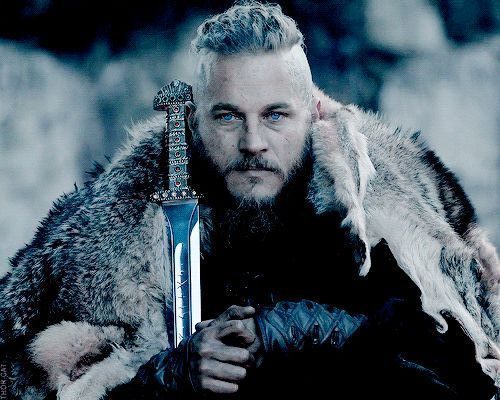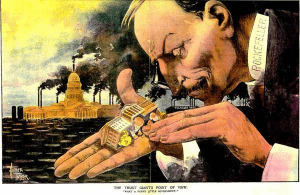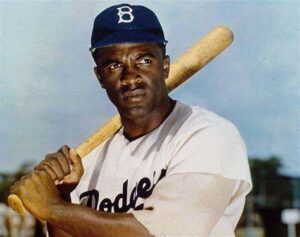For three hundred years, beginning in the ninth century, they sailed the known world and discovered lands beyond their maps.1 They pillaged the peoples of England and France, canals along Middle Eastern coasts, and even their own Scandinavia, venturing as far as the east coast of North America. Being given names, such as pirates, barbarians, monsters, and farmers, today we know them as Vikings. Their people did not fear death in combat, and they would go to great lengths to find a worthy way to die. Being killed heroically with a weapon in hand could get the attention of a Valkyrie, or angelic female warrior, to determine if ones death was worthy. If deemed worthy one would ascend to Valhalla, the Nordic afterlife for a warrior, where one would brag about one’s adventures and fight to the death daily in the army of Oden, chieftain of the Norse gods, as preparation for the end of the world. One man that stood out among these hardened people and became one of the first Scandinavian kings was Ragnar Lothbrok.2
Being born just before the turn of the year 800 CE, Ragnar Lothbrok brought together the Scandinavian war bands under his command. With Europe poorly protected, and with Charlemagne’s rule coming to an end, Ragnar took the advantage and led his Vikings on many campaigns to loot Europe of its treasures.3 With little real knowledge of the Norsemen, the peoplesand treasures of Europe were easy targets. When in the fighting line, Ragnar was said to dwarf his companions that stood around him and fought in his armies as a berserker.4 A berserker is a warrior that fights in a rage-filled trance, being able to take on multiple injuries before falling in battle. Ragnar was admired for his skills in battle and for his strategic mind. His armies could hold their own against Charlemagne’s forces due to his strategic cunning. Ragnar is even father to other well-known Viking warriors, Bijorn Ironside, Hubb, and Ivar the Boneless, a figure of terror in Irish and English storytelling.5

The untimely demise of Ragnar Lothbrok became a story of revenge. With so many battles and victories against the Anglo Saxons, Ragnar had created enemy in Aelle, ruler of York. During Ragnar’s last battle, he was captured by the Anglo Saxons and became a prisoner. In honor of his new prisoner, Aelle, ruler of York, ordered his men to build a pit of snakes for Ragnar to be thrown into. As the snake venom was running through Ragnar’s veins, he is reported to have uttered, as his last words, “How the little pigs will grunt when they hear how the old boar has died,” referring to his sons as the avengers of his death.6 The death of Ragnar Lothbrok supposedly triggered a new age of Viking attacks. Those attacks had the ferocity and intensity that Vikings later became known for. Seeking to avenge their father’s death, Ivar the Boneless and his two brothers led their Viking forces to East Anglia in 865 CE. In the name of revenge, the brothers captured Aelle and killed him with the rite of the blood eagle.7 This rite was a gruesome and painful form of execution by torture that resulted in a slow death; after the torture, the poor soul subjected to the rite was to be tied by the wrists in the air to two separate trees, to resemble a bird in flight, to honor Oden’s sacred bird, the eagle. The ritual was so gruesome that it was hardly ever used and only on those deserving of it.

The story of Ragnar Lothbrok became a legend and was written into the Icelandic sagas and the Gesta Danorum.8 Over time he became another epic hero in a story with impossible adventures. Between the seventh and ninth centuries, multiple stories and lives of other people named Ragnar have surfaced. Despite these multiple stories, there will only be a true original Ragnar Lothbrok, the one that forced his way into history and built the reputation of the Vikings.
- Gale Encyclopedia of World History, 2008, s.v. “Viking Raids and Norman Conquests (8th to 11th Centuries).” ↵
- P.D. Kirby, “Review of A.P. Smyth’s Scandinavian Kings in the British Isles 850-880,” The English Historical Review 94, no. 370 (January 1979): 162-163. ↵
- P.D. Kirby, “Review of A.P. Smyth’s Scandinavian Kings in the British Isles 850-880,” The English Historical Review 94, no. 370 (January 1979): 162-163. ↵
- Gale Encyclopedia of World History, 2008, s.v. “Viking Raids and Norman Conquests (8th to 11th Centuries).” ↵
- Encyclopedia of the Barbarian World, 2004, s.v. “Bronze Age to Early Middle Ages,” by Peter Bogucki and Pam J. Crabtree. ↵
- Encyclopedia of the Barbarian World, 2004, s.v. “Bronze Age to Early Middle Ages,” by Peter Bogucki and Pam J. Crabtree. ↵
- Roberta Frank, “Viking Atrocity and Skaldic Verse: The Rite of the Blood Eagle.” The English Historical Review 99, no. 391 (April 1984):332-343. ↵
- Neil Schlager and Josh Lauer, Science and Its Times (Detroit: Gale, 2001), 100-101. ↵



50 comments
Anthony Robledo
Great article! I really loved the first picture, and your introduction was really attention grabbing. I really enjoyed how you talked about his death. The death that sparked a new age in Viking attacks. Honestly, I know very little on this topic before reading and now I feel informed. The Gesta Danorum is something I never even heard of so kudos on picking an awesome topic. overall, good job!
Andrea Chavez
It was a very interesting topic; the image was defiantly eye catching. I think this essay was really general; I really could not get the idea of what Ragnar Lothbrok really did or who he really was. But I did find interesting the revenge his “sons” took upon his death. Although it did sparkle some curiosity as to what the ritual of the eagle is.
Andrew Rodriguez
I was completely unaware of who this guy was in history. He seemed to have a profound affect on the history of his people. Bringing together the Vikings under one command, was just one of the many accomplishments this guy had under his belt. His death was very terrible and tortuous way to die. The way the Vikings believed into die in honor in battle. Must have made them so terrifying to fight knowing they came in there to do something heroic.
Grace Bell
This article was very interesting. I really got a feel for Ragnar as a ruler and what life was like for him and what life was like as a Viking in general. This article gives a great description of Ragnar’s death and how his sons avenged him. I really liked the story and feel well informed on Ragnar’s rule and what he did as a ruler.
Benjamin Voy
I am a big fan of Ragnar Lothbrok and have watched the TV Episodes “Vikings”, one of my favourite! It shows that when you think outside of the box you can achieve great things and that you should never just do what everyone else is doing and if you have your own ideas you should voice them. This was a greatly structured article. Fantastic read
Tyler Sleeter
Great story. I do not know much about Ragnar Lothbrok aside from a popular television show. I find it interesting that he was able to bring the bands of Vikings together and then go on raids to loot from the Anglo-Saxons. It must have been satisfying to them when they were finally able to capture and punish Ragnar. I like that his story has become legend with many tales attributed to him that he could not possibly have done.
Christine Sackey
This was very cool! The Vikings seemed like a tough group of people and this article defiantly confirmed that. To me, Ragnar Lothbrok was a strong man who could handle anything. I thought his last words were interesting. It definitely showed how close he was to his armies. That type of loyalty is certainly something one characteristic that can be admired about the Vikings.
Sebastian Castro Ramos
Vikings have a reputation of being tough and brave warriors, an it is interesting to track down who was who set an example and started to set this reputation. This article also shows the importance vikings gave to family or their tribe when Ragnar’s sons set to avenge his father and gave the worst punishment of all to Aelle. This was an interesting and very engaging article.
Edward Cerna
This was a very interesting article to read. I had never heard of the Viking Ragnar lothbrok. I like how you talked about the story. It find it bothering how he was killed by a pit if snakes but it also cool at the same time. This article really kept me engaged. Good job.
Samman Tyata
Wow! I really liked the way how you have structured you article. Honestly, I had never heard about this topic before. It was interesting to know that Ragnar Lothbrok brought together the Scandinavian war bands under his command. Furthermore, it’s amazing that the story of Ragnar Lothbrok became a legend and was written into the Icelandic sagas and the Gesta Danorum. Moreover, I really liked the pictures you used. To sum it up, it was a good read.